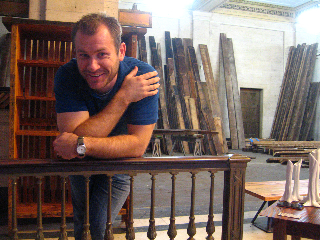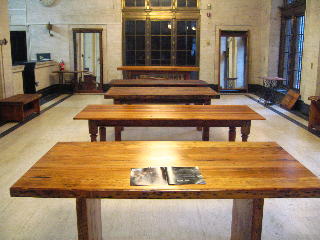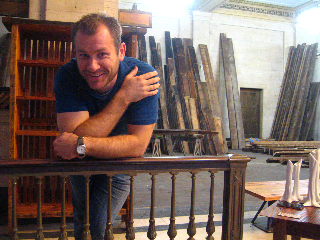 Designer Will Phillips (pictured) and John Bolster have opened Sandtown Millworks in a former bank with help from a Operation:Storefront grant.Photo: Elizabeth Evitts DickinsonLast week kicked off that special time of year when indulgence and guilt face off in the ultimate death match, prompting headlines like this one in the “healthy living” section of the Huffington Post: “Can holiday shopping count as exercise?” (Uhm, no.)
Designer Will Phillips (pictured) and John Bolster have opened Sandtown Millworks in a former bank with help from a Operation:Storefront grant.Photo: Elizabeth Evitts DickinsonLast week kicked off that special time of year when indulgence and guilt face off in the ultimate death match, prompting headlines like this one in the “healthy living” section of the Huffington Post: “Can holiday shopping count as exercise?” (Uhm, no.)
This year, small businesses across the country are harnessing the spirit of the Occupy movement in the hopes of reclaiming the spirit of the holiday season. If you plan to shop, they say, buy local, buy independent, support your community. Their mantra: Re-Occupy Main Street.
Thing is, cities like Baltimore, where I live, don’t have as many “Main Street” stores to occupy these days. Sixty years ago, my grandmother could take the bus downtown to Howard Street, walk from shop to shop, and cross everyone off her list. Today, Howard Street is more vacancy than vibrancy. Most of the street-level real estate is boarded up or abandoned.
A new grant program called Operation:Storefront aims to change that. The nonprofit Downtown Partnership of Baltimore launched the initiative last year with the goals of helping entrepreneurs and artists find affordable storefront space and generating more foot traffic downtown.
I first learned about this from my brother, who works at the partnership. He told me that the group wanted to help the community get back to the Jane Jacobs ideal of the mixed-use, downtown retail neighborhood, so it issued a request for proposals last fall and entertained all types of ideas.
“Individuals, artists, existing groups that wanted a second location, or a start up — we looked at all proposals,” says Mackenzie Paull, the partnership’s retail and economic development manager and the person in charge of Operation:Storefront. “The only critical component for us was that it engage people as they go by or bring people downtown to the site.”
 The Sandtown Millworks storefront is located in a former bank in downtown Baltimore.Photo: Elizabeth Evitts DickinsonTwelve individuals and businesses — ranging from artists and performance groups to a barbershop, a fashion designer, and a design center — were awarded up to $10,000 to occupy a physical location downtown. Paull helped broker deals with landlords for street-level space varying in size from 600 to 8,000 square feet, and with leases ranging from two months to three years. The Downtown Partnership also gave grantees business advice on how to scale their ideas to a physical space. The program not only fills empty storefronts, enlivening the street, it also allows people to incubate an idea on a short-term basis with the goal of building a business long-term.
The Sandtown Millworks storefront is located in a former bank in downtown Baltimore.Photo: Elizabeth Evitts DickinsonTwelve individuals and businesses — ranging from artists and performance groups to a barbershop, a fashion designer, and a design center — were awarded up to $10,000 to occupy a physical location downtown. Paull helped broker deals with landlords for street-level space varying in size from 600 to 8,000 square feet, and with leases ranging from two months to three years. The Downtown Partnership also gave grantees business advice on how to scale their ideas to a physical space. The program not only fills empty storefronts, enlivening the street, it also allows people to incubate an idea on a short-term basis with the goal of building a business long-term.
Sandtown Millworks is one of the small businesses benefiting from a Storefront grant. Founded in November of last year by designers Will Phillips and John Bolster, the company salvages wood from the demolition of Baltimore rowhouses and transforms it into furniture. “Most of the city of Baltimore was built with this old growth lumber that you can’t buy anymore,” Phillips says. “It was cut from trees that were 100 to 200 years old, so it’s dense and has a beautiful wood grain.”
Phillips and Bolster started hauling the wood to a warehouse shop in South Baltimore, taking not only the large and lengthy floorboards, but also the joists, the studs, the roof boards, and the lathe — those thin strips that help hold plaster on the wall and frequently end up in the junk pile of a demo. There they built a furniture line that celebrates the source of the wood, highlighting old nail holes and saw marks. They even use scrap metal from another local craftsman for a unique lag bolt to hold tabletops in place.
Sandtown Millworks could be the business model of the Re-Occupy movement: They take something that has lost its commercial value and, through hard work and skill, convert it into a beautiful and useful product. They build relationships with local craftsmen, like the metalworker, and they market their work to the masses from a stall at the Sunday farmers market. Thanks to Storefront, they now have a showroom in a former bank where potential customers can peruse furniture in a beautiful space with vaulted ceilings and marble floors.
 Sandtown Millworks makes tables from old growth lumber salvaged from demolished rowhouses. The new showroom has netted two to three commissioned pieces a week.Photo: Elizabeth Evitts DickinsonThat Phillips and Bolster sell the furniture from the shell of a former bank seems a fitting tribute to the spirit of this endeavor. It’s a new kind of commodity, one based in human interaction, community investment, and upcycling.
Sandtown Millworks makes tables from old growth lumber salvaged from demolished rowhouses. The new showroom has netted two to three commissioned pieces a week.Photo: Elizabeth Evitts DickinsonThat Phillips and Bolster sell the furniture from the shell of a former bank seems a fitting tribute to the spirit of this endeavor. It’s a new kind of commodity, one based in human interaction, community investment, and upcycling.
“We take old wood people have discarded and make it something beautiful,” Phillips says. “It’s the same thing Operation:Storefront does — taking these old spaces and polishing them up and breathing some life back into them.”
Baltimore isn’t the only city doing this. Paull was inspired by a similar concept in Connecticut called Project Storefronts New Haven. The New Haven project has a bit of a different structure, according to Executive Director Margaret Bodell. Bodell lines up landlords in downtrodden neighborhoods who are willing to offer free rent for 90 days. She then matches the space with a business, which gets $500 to help build out the store as well as support with marketing and business strategy.
Since the project’s inception two years ago, Bodell says more than 30 entrepreneurs have tested business models, generating over $100,000, and foot traffic in the neighborhood where the stores are located has seen a marked increase. The first business to open — a co-working incubator space — was so successful that the owners ended up renting more square footage and signing a five-year lease. Perhaps just as important, the merchants in the program have galvanized the community through new events and activities.
The storefronts idea helps small business gain footing while helping landlords see the value in taking a chance on someone they may have considered too risky. It’s one better than the transient pop up shop model, Bodell says, where a business briefly occupies a space to sell goods, knowing that it will close shop. “The pop up is a flash in the pan and then it’s gone. We want people to pop in and stay there.”



